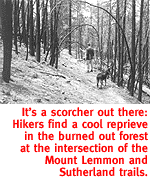Graveyard Shift
Traipsing Through The 'Tombstones' Of Burned-Out Trees On AMount Lemmon Hike.
By Kevin Franklin
IT LOOKS LIKE snow. A grove of ferns atop the
Catalina Mountains appears to be buried in two inches of snow
in June. In fact, they're dusted with tens of thousands of cottony
aspen tree seeds.
 Vaguely similar to dandelion spores, the aspen progeny launch
themselves from hundreds of catkins 30 feet up in the air. Catkins
look like cocoons, but are really the flowers of the aspen tree.
After pollination, the seeds and their puffy parachutes grow on
the catkin. With the slightest breeze they drift to the forest
floor like a mid-summer snowstorm.
Vaguely similar to dandelion spores, the aspen progeny launch
themselves from hundreds of catkins 30 feet up in the air. Catkins
look like cocoons, but are really the flowers of the aspen tree.
After pollination, the seeds and their puffy parachutes grow on
the catkin. With the slightest breeze they drift to the forest
floor like a mid-summer snowstorm.
It's a comforting mirage. Though we're at 9,200 feet and 30 degrees
cooler than Tucson, visible in the valley below, it's still sweating
hot.
We've already hiked the Lemmon Park Trail to the Mount Lemmon
Trail, where we passed the aspens. We plan to follow Mount Lemmon
Trail down to the Wilderness of Rocks Trail and then back up the
little-used Lower Mount Lemmon Trail. All told, an eight-and-half
mile trek. That doesn't sound like much, but it encompasses 4,000
feet of elevation change.
On the Mount Lemmon Trail, we pass the Fortress. Looming 400
feet above the surrounding pines, the Fortress is aptly named.
There are three giant outcrops here known as the Summit Crags.
To the east of the Fortress lie the Ravens, a collection of jointed
columns, and then Rappel Rock. The Fortress and The Ravens are
closed to everyone in the summer because endangered peregrine
falcons nest here. The 500-foot sheer faces of Rappel Rock
draw gobs of climbers to the cooler climes.
We peek through the undergrowth at the stony head of the Fortress
and quietly continue on our way. Today's loop will take us all
the way around the Summit Crags. Our next good view of them will
be from thousands of feet below amid the Wilderness of Rocks,
a jumble of giant boulders perched on top of one another.
At the intersection of the Mount Lemmon Trail and Sutherland
Trail, we enter the area of forest burned in 1994.
 Burned forests remind me of graveyards--beautiful, solemn graveyards.
It seems to me graveyards are more about life than death. A grave
stands as a final monument to a life, a sort of summary. Looking
at the burned trunks and blackened floor, my imagination takes
me to this place before the fire. In my mind, the twists and bends
in the arms of a giant alligator juniper become lush again. I
see it through hundreds of years as literally millions of berries
are carried off this tree by hungry birds.
Burned forests remind me of graveyards--beautiful, solemn graveyards.
It seems to me graveyards are more about life than death. A grave
stands as a final monument to a life, a sort of summary. Looking
at the burned trunks and blackened floor, my imagination takes
me to this place before the fire. In my mind, the twists and bends
in the arms of a giant alligator juniper become lush again. I
see it through hundreds of years as literally millions of berries
are carried off this tree by hungry birds.
In the present, a few of the seeds in those berries have
taken root elsewhere on this mountain and grown into trees already
ancient in human terms by the time I pass their cremated ancestors.
They will continue long after me.
Even the graveyard itself will soon be more about the living
than memories of the dead. Grasses and seedlings are sprouting
where before there was not enough light to sustain them. Perhaps
a few of the aspen seeds we saw earlier will blow over here and
take root, using this clearing just like the trees they came from
used another clearing many years ago.
Seeing the young trees is like seeing the grandchildren of
a good man visiting his grave.
We pass through the quiet forest and on toward our rendezvous
with the Wilderness of Rocks Trail. We follow that trail down
to Lemmon Creek, which usually runs, at least a little bit, all
summer long. Even in this record drought there are a few puddles
left, but no moving water.
We press on. The second time we cross Lemmon Creek we find
the Lower Mount Lemmon Trail junction. About a mile onto this
trail is where the going gets tough. Along a half-mile stretch
of this steep two-mile trail, the path climbs 800 feet. That means
for every two feet forward, we're climbing more than a half-foot
up. That's like climbing a half-mile-long set of stairs.
Trudging along, we eventually reach the top, seven hours after
our departure. Low on water and exhausted, we rejoice at returning
to the meadow of fuzzy snow.
GETTING THERE
Take the Catalina Highway all the way to the top, past the ski
resort. The trail starts at the designated parking area just below
Steward Observatory. Mapage: The Santa Catalina Recreation
Map is just the thing for this trip.

|
